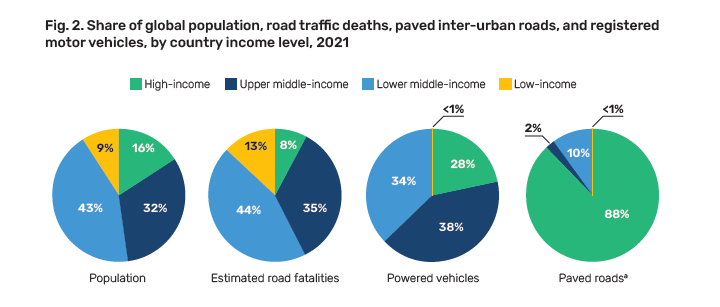WHO Global Status Report on Road Safety 2023
- Details
- Created: Monday, 08 January 2024 16:28
WHO Global Status Report on Road Safety 2023

The Global Status Report on Road Safety 2023 launched by WHO states that urgent and stronger action is needed in order to reduce road deaths, injuries and provide safer, more affordable, accesible and sustainable mobility by 2030.
According to the report, 1.19 million people are killed on the world’s roads every year, a decrease of 5% since 2010. In that time, 10 countries achieved at least a 50% reduction in road deaths and 85 achieved reductions between 10-49%, proving that the 2030 road safety targets are possible if governments invest in the right actions. The report notes that some of the greatest reductions were made “where the safe system approach – which puts people and safety at the core of mobility systems – was applied.”
On the other hand, in those countries where governments are still not taking road safety seriously enough, road deaths increased. For example, the report remarks that highincome countries have 16% of the world’s population, 28% of the world’s vehicle fleet, 88% of all paved inter-urban roads, and 8% of fatalities. By contrast, low-income countries have 9% of the world’s population, less tan 1% of the world’s powered vehicle fleet and paved inter-urban roads, yet 13% of fatalities.

Governments must implement interventions that have been proven to save lives and reduce injuries
The Global Alliance of NGOs for Road Safety (the Alliance) claimed that only three countries reported having laws mandating national 30 km/h limits in urban areas where people and vehicles mix, and, while 160 countries reported having legislation on motorcycle-helmet use, only 54 of those meet WHO best practice.
Road crashes remain the leading cause of death for those aged 5–29 years old. In addition to this, more than half of road deaths occur among pedestrians (23%), cyclists (6%), motorcyclists (21%), and micro mobility users such as e-scooters (3%).
The report shows how these at-risk groups are overlooked in road infrastructure: only 21% of assessed roads meet a minimum 3-star safety standard for pedestrians and only 0.2% of roads have cycle lanes. The report also warns that our car-centric mobility systems are unsustainable: the number of motorized vehicles on the world’s roads has increased by 160% since 2010, and, with 60% of the global population expected to live in urban settings by 2030, “increased demand for mobility will exceed the capacity of most current systems".
Rethinking mobility to prioritize walking, cycling, and public transport is essential for people and the planet, tackling global crises of climate, health, and inequity. To make that shift, journeys must be safe for all road users.

